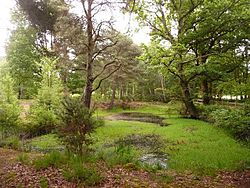Ferndown Common facts for kids
Quick facts for kids Ferndown Common |
|
|---|---|

A small pond on Ferndown Common
|
|
| Type | Heath |
| Location | Dorset, England |
| Nearest town | Ferndown |
| Area | 64.7 hectares (160 acres) |
| Status | SSSI |
Ferndown Common is a very special natural area located near Ferndown in Dorset, England. It's known as a Site of Special Scientific Interest (SSSI) because it's home to many rare plants and animals. This means it's protected by law to keep its unique wildlife safe.
The land is currently owned by the Wimborne Estate. However, it is looked after by a group called the Amphibian and Reptile Conservation Trust (ARC). They work hard to manage the common and protect all the amazing creatures and plants that live there. Ferndown Common was officially recognized as an SSSI in 1984.
Contents
Ferndown Common: A Special Place
What Makes Ferndown Common Unique?
Ferndown Common covers a large area, about 64.7 hectares (which is like 160 football fields!). A big part of this area is heathland. Heathland is a special type of habitat with open, low-growing plants.
Most of the heath here is dry heath, with plants like heather and bell heather. But in some wetter spots, you'll find damp heath plants like cross-leaved heath and purple moor-grass.
Amazing Animals and Plants!
Ferndown Common is a fantastic place for wildlife, especially for some rare species. It's like a natural treasure chest!
Here are some of the special animals you might find:
- The sand lizard (Lacerta agilis) is a beautiful lizard that loves sandy heathland.
- The smooth snake (Coronella austriaca) is a very shy and rare snake.
- The heath grasshopper (Chorthippus vagansand) is a type of grasshopper found only in heathland areas.
- The Dartford warbler (Sylvia undata) is a small bird that makes its home in the low bushes of the heath.
Other cool animals that live here include the silver-studded blue butterfly (Plebejus argus), which has shiny blue spots on its wings. You might also spot the European nightjar (Caprimulgus europaeus), a bird that hunts insects at night, and the European stonechat, a small, colorful bird.
Ponds Full of Life
In the south-east part of Ferndown Common, there are several small ponds. These ponds are super important for wildlife, especially for insects and amphibians.
You can find at least 14 different types of dragonflies here! Most of these are heathland dragonflies, which means they prefer this kind of habitat. The ponds are also home to many common frogs (Rana temporaria) and palmate newts (Triturus helveticus). Even though these animals are common, their numbers are declining in some places, so the ponds at Ferndown Common are very important for them.
A Look at the Land and Its History
The land at Ferndown Common is mostly flat. However, there are a few small pits where clay or gravel might have been dug out long ago. You can also see a lot of old banks that mark the edges of fields. These banks date back to the 1700s and 1800s, when laws called the Inclosure Acts changed how land was used.
There's also a steep slope, called an escarpment, that goes down towards the Stour Valley. This slope was once a busy route for people traveling through the area. During the Second World War, people tried to grow crops on some parts of the common. You can still see the marks of this farming, like small ridges and furrows in the ground.
In 2003, Ferndown Common was officially named a town green. This means it's a protected open space for local people to enjoy.

